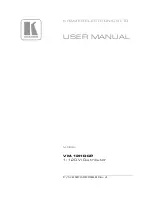
Final Installation and Operation
35
Overload Protection
There are two types of maximum output limit: warning and trip. Contact ETC technical services
for assistance with warning and fault conditions.
Warning
On ArcLamp Driver 350 and 700 models only, the "Channel OK" LED will remain solid on and
the Channel Limit LED will light if the current drawn on any channel exceeds the warning limits.
Trip
On all models, lamps will flash if the current drawn on any output channel exceeds the trip
limits. The protection circuit retries the connection every 1 second until the trip condition is
resolved or the main circuit breaker supplying power to the ArcLamp Driver is shut off. If all
channels draw current below the trip limits, the circuit will reconnect and lamps will stop
flashing.
Trip LED behavior
On ArcLamp Driver 350 and 700 models only, the "Channel OK" LED and Channel Limit LED
will alternate flashing if the current drawn on any output channel exceeds the trip limits.
Channel Limit LEDs will turn off and "Channel OK" LEDs will turn solid on when the circuit
reconnects.
Warning Limits and Trip Limits
Driver Description
Warning Limits
Trip Limits
Single
Channel
Number of Channels Per
Bridge
Single
Channel
Number of Channels Per
Bridge
2
3
4
2
3
4
ArcLamp Driver 150 or
ArcLamp Emergency
Driver 150
NO WARNING OR TRIP LEDs
If circuits are overloaded on an ArcLamp Driver 150, output may appear
dim or loads may not light. Contact ETC Technical Services for assistance.
Wall-Mount ArcLamp
Driver or ArcLamp
Emergency Driver350
3.0 A
5.8 A
8.1 A
9.8 A
3.6 A
7.0 A
9.8 A
12.0 A
Rack-Mount ArcLamp
Driver or ArcLamp
Emergency Driver 350
3.0 A
5.6 A
8.6 A
11.0 A
3.6 A
6.7 A
10.6 A
13.0 A
Wall-Mount ArcLamp
Driver or ArcLamp
Emergency Driver700
6.1 A
12.0 A
NOT POSSIBLE
7.1 A
14.2 A
NOT POSSIBLE
Rack-Mount ArcLamp
Driver or ArcLamp
Emergency Driver 700
6.1 A
11.0 A
NOT POSSIBLE
7.1 A
13 A
NOT POSSIBLE
The current drawn by large numbers of ArcLamps is less than the calculated ideal, which allows more
ArcLamps to be driven by a single bridged channel than you might expect from calculations.
See
Bridge Output Channels on page 37
for more information about bridging channels.
















































